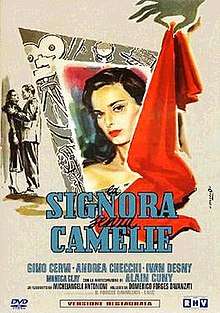The Lady Without Camelias
The Lady Without Camelias (Italian: La signora senza camelie) is a 1953 Italian black-and-white drama film directed by Michelangelo Antonioni and starring Lucia Bosé, Gino Cervi, and Andrea Checchi. Based on a story by Antonioni, the film is about a new starlet who is discovered and her experiences in Italian films.[1] The film has been called "Antonioni's most unjustly neglected fiction feature."[2] Filmed on location in Rome and Venice,[3] The Lady Without Camelias was released on 27 February 1953 in Italy.
| The Lady Without Camelias | |
|---|---|
 Theatrical release poster | |
| Directed by | Michelangelo Antonioni |
| Produced by | Domenico Forges Davanzati |
| Screenplay by |
|
| Story by | Michelangelo Antonioni |
| Starring |
|
| Music by | Giovanni Fusco |
| Cinematography | Enzo Serafin |
| Edited by | Eraldo Da Roma |
Production company |
|
| Distributed by | Ente Nazionale Industrie Cinematografiche |
Release date |
|
Running time | 105 minutes |
| Country | |
| Language | Italian |
Plot
A young shop assistant named Clara Manni (Lucia Bosé) is selected by movie executive Gianni (Andrea Checchi) for his new film, Woman without Destiny. When test screenings reveal that the public is enamoured with Clara, but less enthusiastic about the film itself, producer Ercole (Gino Cervi) sees an opportunity to take advantage of his actress' shapely presence and spice the film up a bit, with less attention to detail and more overt displays of passion. Clara becomes compromised when she marries Gianni, who becomes jealous over the provocative marketing for her film, and categorically states that he doesn't want her involved with it anymore. She reluctantly agrees, and after requesting a more serious vehicle for her, they set about on a new version of the daunting trial of Joan of Arc, with Gianni in the director's chair. The film is panned when premiered at the Venice Film Festival, and with both their reputations in tatters, Clara is forced to evaluate their marriage and the career that she has embarked upon.
Cast
- Lucia Bosé as Clara Manni
- Gino Cervi as Ercole
- Andrea Checchi as Gianni Franchi
- Ivan Desny as Nardo Rusconi
- Monica Clay as Simonetta
- Alain Cuny as Lodi
- Gisella Sofio as Simonetta's Friend
- Anna Carena as Clara's mother
- Enrico Glori as Director[4]
Production
The film's sets were designed by the art director Gianni Polidori. It was made at the Cinecittà Studios, which also appear as a setting in the film.
- Filming locations
Release
The movie was released on Blu-ray and DVD on 21 March 2011 in the United Kingdom.[5]
References
- "The Lady Without Camelias". IMDb. Retrieved 7 August 2018.
- Rosenbaum, Jonathan (1975). "La Signora Senza Camelie". Jonathan Rosenbaum. Retrieved 7 August 2018.
- "Locations for The Lady Without Camelias". IMDb. Retrieved 7 August 2018.
- "Full cast and crew for The Lady Without Camelias". IMDb. Retrieved 7 August 2018.
- "La Signora Senza Camelie Blu-ray". Retrieved 7 August 2018.